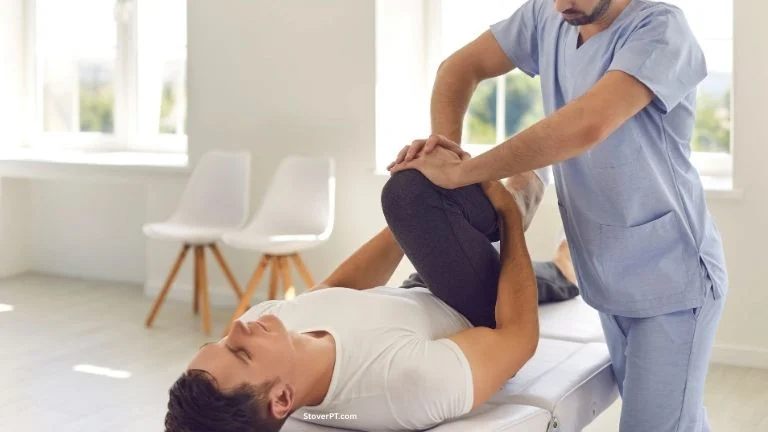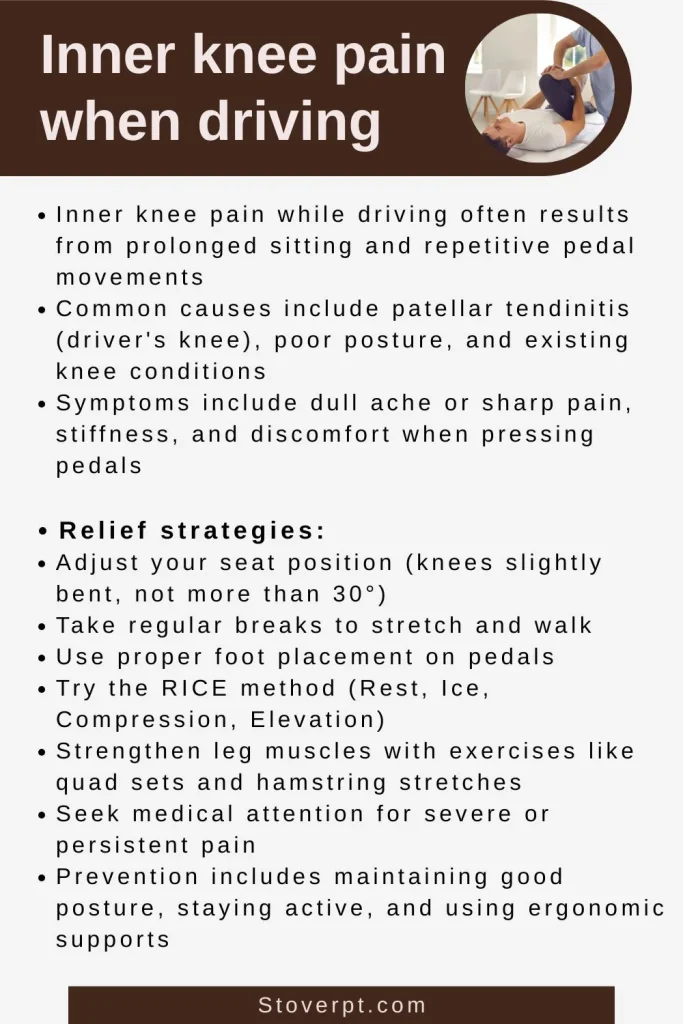Inner Knee Pain When Driving: Causes and Solutions

Inner knee pain when driving is often caused by prolonged sitting, repetitive motions, and poor posture. It can result from conditions like patellar tendinitis, osteoarthritis, or muscle imbalances. Proper ergonomics and regular breaks can help alleviate symptoms.
Understanding Inner Knee Pain While Driving
Inner knee pain, also known as medial knee pain, is a common issue that many drivers experience, especially during long trips or frequent commutes. This discomfort can range from a mild ache to a sharp, persistent pain that affects your ability to operate a vehicle safely and comfortably. To address this problem effectively, it’s crucial to understand its causes, symptoms, and potential treatments.
Causes of Inner Knee Pain When Driving
Several factors can contribute to inner knee pain while driving:
- Prolonged sitting: Staying in the same position for extended periods can lead to stiffness and discomfort in the knee joint.
- Repetitive motions: Constantly moving your foot between the gas and brake pedals can cause strain on the knee tendons and muscles.
- Poor posture: Incorrect seating position can put extra pressure on your knees and lead to pain.
- Existing knee conditions: Conditions like osteoarthritis or previous injuries can be exacerbated by driving.
- Vehicle ergonomics: Improper seat height, angle, or pedal placement can contribute to knee strain.
Common Conditions Associated with Inner Knee Pain While Driving
- Patellar tendinitis: Also known as “jumper’s knee” or “driver’s knee,” this condition involves inflammation of the tendon connecting the kneecap to the shinbone.
- Osteoarthritis: This degenerative joint disease can cause pain and stiffness in the knee, which may worsen during driving.
- Medial collateral ligament (MCL) injury: Strain or tears in the MCL can cause pain on the inner side of the knee.
- Meniscus tears: Damage to the cartilage in the knee can lead to pain, especially when twisting or turning the knee.
- Pes anserine bursitis: Inflammation of the bursa (fluid-filled sac) on the inner side of the knee can cause pain during driving.
Symptoms of Inner Knee Pain When Driving

Recognizing the symptoms of inner knee pain while driving is crucial for early intervention and treatment. Common symptoms include:
- Dull ache or sharp pain on the inner side of the knee
- Stiffness in the knee joint, especially after long periods of driving
- Difficulty fully extending or flexing the knee
- Swelling or tenderness around the knee area
- A feeling of instability or weakness in the knee
- Pain that worsens when pressing the pedals or getting in and out of the car
It’s important to note that symptoms can vary depending on the underlying cause of the pain. If you experience persistent or severe knee pain while driving, it’s advisable to consult a healthcare professional for a proper diagnosis.
How to Alleviate Inner Knee Pain When Driving
Addressing inner knee pain while driving involves a combination of ergonomic adjustments, lifestyle changes, and targeted exercises. Here are some effective strategies to help reduce discomfort:
1. Improve Your Driving Posture
Proper posture is crucial for reducing strain on your knees while driving. Follow these tips:
- Adjust your seat so that your knees are slightly bent when fully pressing the pedals.
- Keep your knees aligned with your hips, avoiding any outward rotation.
- Ensure your seat is at a height that allows your thighs to be parallel to the floor.
- Maintain a slight bend in your elbows when holding the steering wheel.
2. Take Regular Breaks
On long drives, it’s essential to take frequent breaks to stretch and move your legs:
- Stop every 1-2 hours to walk around and stretch your legs.
- Perform simple knee exercises during breaks, such as leg extensions or gentle squats.
- Use rest stops as an opportunity to improve circulation and reduce stiffness.
3. Use Supportive Accessories
Certain accessories can help provide additional support and comfort while driving:
- Use a lumbar support cushion to maintain proper spine alignment.
- Consider using a knee support brace if recommended by your healthcare provider.
- Place a small cushion under your thighs to reduce pressure on your knees.
4. Adjust Your Vehicle’s Settings
Make sure your vehicle is set up to minimize strain on your knees:
- Adjust the steering wheel position to allow for comfortable arm placement.
- Ensure the pedals are at a comfortable distance, allowing for a slight bend in your knees.
- Use cruise control on long highway drives to give your right leg a rest.
5. Strengthen and Stretch Your Leg Muscles
Regular exercise can help support your knees and reduce pain:
- Perform exercises that strengthen the quadriceps, hamstrings, and calf muscles.
- Practice stretching exercises for your leg muscles before and after driving.
- Consider low-impact activities like swimming or cycling to improve overall leg strength.
Exercises to Relieve Inner Knee Pain
Incorporating specific exercises into your routine can help alleviate inner knee pain and prevent future discomfort while driving. Here are some effective exercises:
1. Quad Sets
- Sit with your leg extended and your back supported.
- Tighten the muscle on top of your thigh, pushing the back of your knee down.
- Hold for 5-10 seconds, then relax.
- Repeat 10-15 times for each leg.
2. Straight Leg Raises
- Lie on your back with one leg bent and the other straight.
- Tighten the quadriceps of the straight leg and lift it to the height of the opposite knee.
- Hold for 5 seconds, then lower slowly.
- Repeat 10-15 times for each leg.
3. Hamstring Stretches
- Sit on the edge of a chair with one leg extended.
- Lean forward from your hips, keeping your back straight.
- Hold the stretch for 15-30 seconds.
- Repeat 3-5 times for each leg.
4. Calf Raises
- Stand with your feet hip-width apart, holding onto a chair for balance.
- Slowly rise up onto your toes, then lower back down.
- Perform 2-3 sets of 10-15 repetitions.
5. Wall Slides
- Stand with your back against a wall, feet shoulder-width apart.
- Slowly slide down the wall until your knees are bent at about 45 degrees.
- Hold for 5-10 seconds, then slide back up.
- Repeat 10-15 times.
Remember to perform these exercises gently and stop if you experience any pain. It’s always best to consult with a physical therapist or healthcare provider before starting a new exercise routine, especially if you have existing knee issues.
When to Seek Medical Attention
While many cases of inner knee pain when driving can be managed with self-care measures, there are instances where professional medical attention is necessary. Seek medical help if:
- The pain is severe or persists despite home remedies
- You experience swelling, redness, or warmth around the knee
- Your knee feels unstable or gives way
- You have difficulty bearing weight on the affected leg
- The pain interferes with your daily activities or sleep
- You notice any clicking, popping, or grinding sounds in your knee
A healthcare professional can provide a proper diagnosis and recommend appropriate treatment options, which may include:
- Physical therapy
- Medications for pain and inflammation
- Advanced imaging tests (X-rays, MRI) if necessary
- Knee braces or supports
- In severe cases, surgical intervention
Prevention Strategies for Inner Knee Pain While Driving
Preventing inner knee pain is often easier than treating it. Here are some strategies to help keep your knees healthy and pain-free during long drives:
1. Maintain a Healthy Weight
Excess weight puts additional stress on your knees. Maintaining a healthy weight can significantly reduce the risk of knee pain and other joint issues.
2. Stay Active
Regular exercise helps keep your muscles strong and flexible, which can protect your knees from strain during driving. Focus on low-impact activities that don’t put excessive stress on your knees.
3. Warm Up Before Long Drives
Before embarking on a long journey, take a few minutes to warm up your muscles and joints. Simple stretches and light exercises can help prepare your body for the drive ahead.
4. Invest in a Comfortable Vehicle
When choosing a vehicle, consider factors like seat comfort, ease of entry and exit, and adjustability of the driver’s seat and steering wheel. These features can make a significant difference in your comfort during long drives.
5. Practice Good Posture Outside of Driving
Maintaining good posture throughout your daily activities can help prevent muscle imbalances that may contribute to knee pain while driving.
6. Stay Hydrated
Proper hydration is essential for joint health. Make sure to drink plenty of water throughout the day, especially before and during long drives.
7. Use Cruise Control Wisely
On long highway drives, using cruise control can give your right leg a break. However, be sure to change positions and move your legs regularly to prevent stiffness.
Ergonomic Adjustments for Comfortable Driving
Creating an ergonomic driving environment is crucial for preventing and managing inner knee pain. Here are some key adjustments to consider:
1. Seat Position
- Adjust the seat height so your hips are slightly higher than your knees.
- Ensure there’s a small gap (about two fingers’ width) between the back of your knees and the edge of the seat.
- Position the seat back at a slight recline (100-110 degrees) to reduce pressure on your spine and knees.
2. Steering Wheel Position
- Adjust the steering wheel so that your arms are slightly bent when gripping it at the 9 and 3 o’clock positions.
- Ensure you can see all dashboard instruments without straining your neck.
3. Pedal Alignment
- Position yourself so that you can fully depress the pedals with a slight bend in your knees.
- Avoid having to stretch or strain to reach the pedals.
4. Lumbar Support
- Use the built-in lumbar support in your seat, or add a small cushion to maintain the natural curve of your lower back.
5. Headrest Position
- Adjust the headrest so that the top of it is level with the top of your head.
- Position it as close to the back of your head as comfortable to provide proper support.
Alternative Transportation Options
If inner knee pain continues to be a significant issue despite implementing the above strategies, it may be worth considering alternative transportation options for some of your trips:
- Public transportation: Buses and trains allow you to rest your knees during travel.
- Carpooling: Sharing driving duties can reduce the time you spend behind the wheel.
- Ride-sharing services: For occasional trips, using services like Uber or Lyft can give your knees a break.
- Cycling: For shorter distances, cycling can be a knee-friendly alternative that also provides exercise.
- Walking: When feasible, walking short distances instead of driving can help improve knee strength and flexibility.
Hard Lump on Shin Bone Treatment






